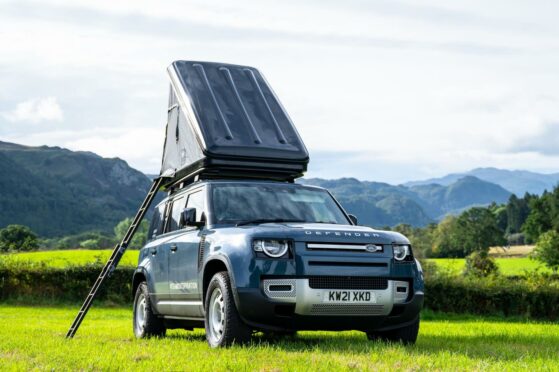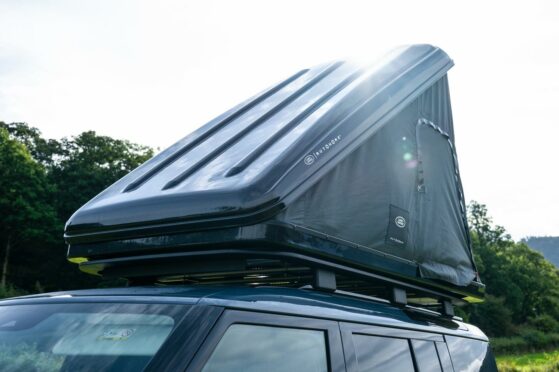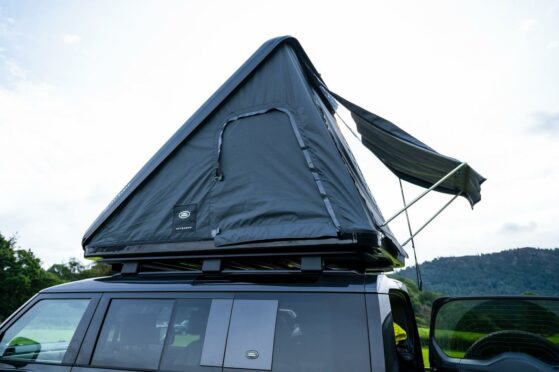Fancy turning your 4×4 into a camper? The £3,200 Autohome roof tent could be the answer.
It’s getting chillier now and those sunny weekend camping days are definitely coming to a close. Looking back on the summer trends, though, campervans, wild camping and driving tours came into their own as we explored the Highlands and islands, and people took advantage of the chance to unwind closer to home.
If you owned a campervan before the pandemic you were in luck, as original manufacturers and independent converters have struggled to keep up with demand for those who wanted to buy.
A camping experience with a difference
Not everyone can afford caravan, though, and not all of us wants to tent down on a soggy campground. Enter, the rooftop tent. It’s is a step away from the usual camping experience but will it make itself felt next year come spring, and is it a realistic alternative to the traditional camping experience?
If you’re new to the concept, it does exactly what it says on the tin. A tent is attached to the roof of your car, meaning you can drive to your destination, park up, and enjoy a night on top of your vehicle.
So with Britain enjoying a wonderful late summer, we decided to give one a go, and see if they’re really worth the expense over a regular tent setup.
Last year, Land Rover teamed up with Autohome, an Italian company specialising in roof tents, to create something specifically for its Defender 4×4.
To put it to the ultimate test, we took the keys and travelled into the country – about 350 miles and six hours each way.
I’ve seen roof tents before, and was expecting a large block to be attached to the roof rails in what aerodynamicists would call a sub-optimal design. So when the Defender pulled up with a sleek roof box I was mighty impressed.
One of my biggest concerns with a six-hour trip in front of me was wind noise buffeting off the tent. However, this narrow box, with its gently sloped angle towards the rear, looked like it would slice through the air with minimal fuss.
I was right. Once up to motorway speeds you’d need to turn the radio off to pick up any buffeting, with the Defender being an ideal companion for a road trip. It didn’t affect fuel economy too badly either, nudging 30mpg on a long, uninterrupted run.
Furthermore, the box is a fibreglass shell that holds the tent materials inside, so it’s solid and secure. There are no worries about debris or stones causing damage at 70mph.
Once on location it was the moment I’d been dreading – building the tent. Having not had time to test it before leaving, my first attempt at assembly would be in front of a group of people.
A simple design with space and length
Fortunately, it couldn’t have been easier. Simply unlatch the back and it naturally lifts into the air. It’s a triangular shape, sitting tall at the front and sloping down to the rear. At its highest point you couldn’t quite stand, but it’s surprisingly spacious inside.
When you’re done, you simply pull on a rope and everything folds back together. You’ll need to walk around and tuck the edges in, before latching it shut again. It takes about five seconds to put up and about 20 seconds to put down. Impressive.
You enter by putting a ladder against the side of the car. This is one of very few slightly negative aspects, as it’s stored in a bag that you need to carry in the car, either folding a rear seat flat or placing it in the rear footwell. If travelling with passengers in the back this could be rather awkward, but it’s a minor issue if not.
Once you climb up to your tent, simply unzip the sides and climb in. There are poles that can attach to the front to make a small porch, too.
It’s surprisingly comfortable, with a thin, memory foam-like mattress. I’d expected it to be quite hard as you’re sleeping on a fibreglass base, but again, I was happily proved wrong as I slept like a log.
It’s long, too, with my six-foot frame able to lie down fully without touching each end. It’s not as spacious as a double bed width-wise, but it sleeps two without having to get too cozy…
Downsides? It rained one evening, and while the tent itself held up by keeping us perfectly dry, it was difficult to know what to do with our clothing. A few more nights with the tent might have raised a more elegant solution, but we saw our choices as either climbing inside with wet clothes and shoes and either shoving them into a corner or on the car roof beneath the tent, or getting changed in the car and trying to get into the tent as quickly as possible.
On the drive home from our weekend away, I was left hugely impressed. Being raised off the ground means you don’t have the cold, damp ground beneath you, while the engineering of the tent and the comfort once inside were as good as you could ask for.
The roof tent is a fantastic product. It’s well engineered, spacious and very comfortable
Here’s the caveat, though – you’d hope that was the case given the price. The Autohome costs about £3,200 from Land Rover retailers or the Autohome website. That’s eye wateringly expensive when you can pick up a pop-up tent for about £20 in your local supermarket.
It also requires the £1,252 Expedition roof rack to be fitted to the Defender, adding to the cost.
In its defence, the roof tent is a fantastic product. It’s well engineered, spacious and very comfortable. It also integrates naturally with the Defender, to the point where you probably wouldn’t need to bother removing it between trips away.
The best way to make a case for it is to consider it as an option when buying the car. A Land Rover Defender starts at about £45,000. The roof box plus roof rails cost about £4,500. Perhaps consider not ticking a few option boxes and do away with a couple of luxuries, and it might start to make more sense.





